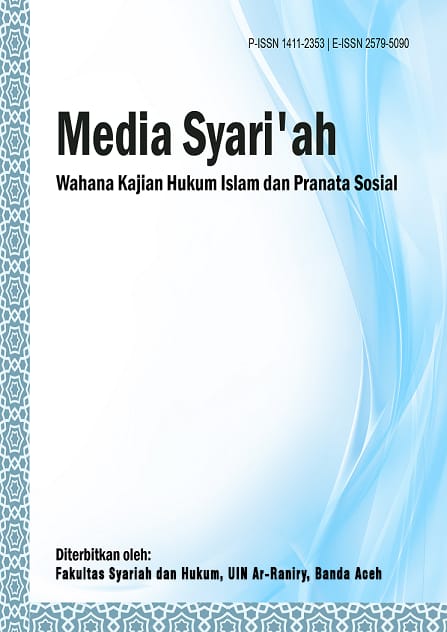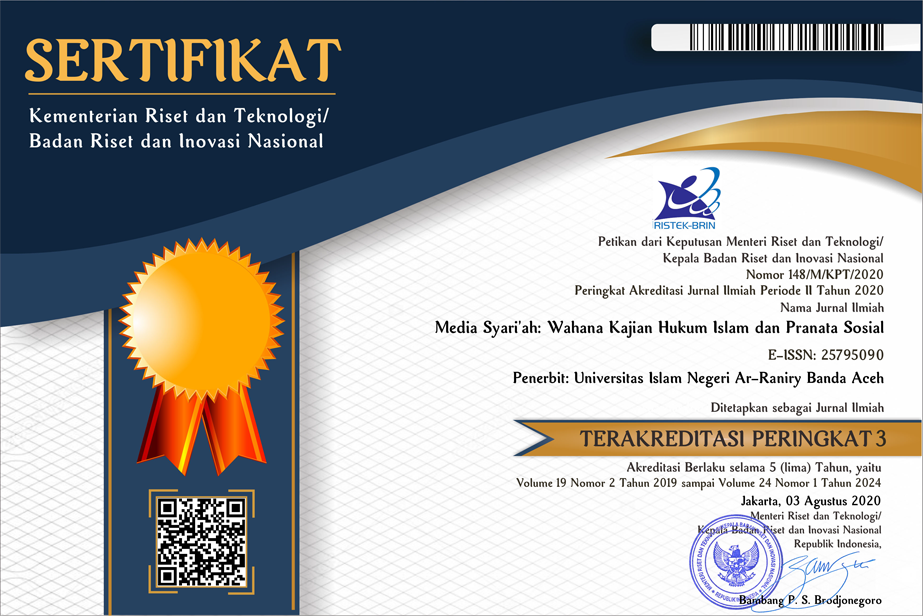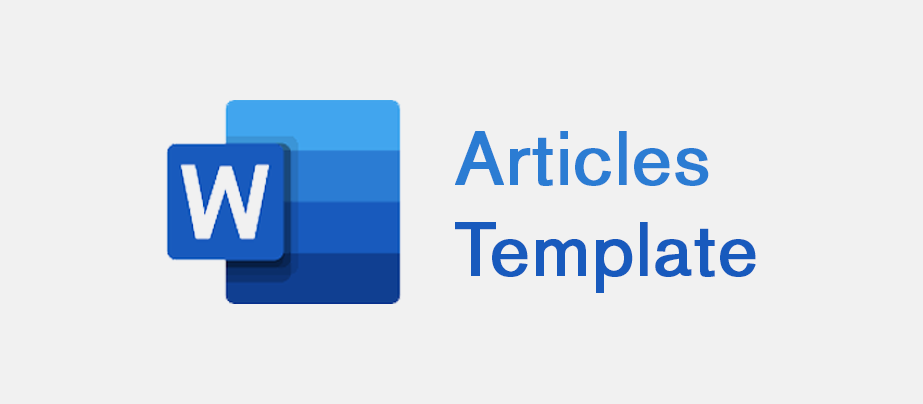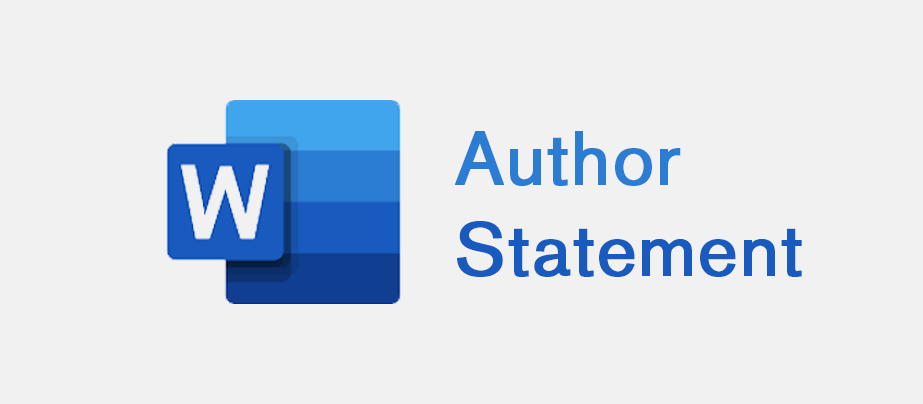Tanggapan Ulama Dayah Terhadap Pembagian Harta Bersama Menurut Pasal 97 KHI
DOI:
https://doi.org/10.22373/jms.v22i1.6615Keywords:
ulama dayah, harta bersama dan Kompilasi Hukum IslamAbstract
Abstrak: Ketentuan tentang cara pembagian harta bersama diatur dalam Kompilasi Hukum Islam pasal 97 dengan pola seperdua. Namun dalam prakteknya, masyarakat di Kabupaten Bireuen melakukan pembagian harta bersama dengan pola sepertiga. Karena itu, muncul pertanyaan apa dasar filosofi pembagian KHI dengan pola seperdua pasal 97 KHI tersebut dan mengapa praktek pembagian harta bersama di Kabupaten Bireuen dilakukan pembagiannya dengan pola sepertiga. Pertanyaan selanjutnya bagaimana tanggapan mereka terkait pola pembagian harta bersama pasal 97 KHI. Ketiga pertanyaan itulah menjadi fokus pembahasan dalam artikel ini. Berdasarkan data yang diperoleh dan wawancara dengan beberapa responden menyatakan bahwa filosofi pembagian harta bersama dengan pola seperdua untuk melindungi dan memperkuat eksistensi perempuan secara finansial. Sedangkan praktek pembagian harta bersama di Kabupaten Bireuen pada umumnya dilakukan dengan pola sepertiga, dalam kasus-kasus tertentu juga diterapkan seperti halnya pola pembagian KHI. Menanggapi ini, ulama dayah di Kabupaten Bireuen tidak menolak rumusan pembagian harta bersama pasal 97 KHI dengan pola seperdua. Keberadaan KHI dengan pola seperdua di tengah masyarakat untuk memperkuat tradisi masyarakat yang melakukan pembagian harta bersama dengan pola sepertiga.
Abstract: Provisions on how to divide shared assets are regulated in Article 97 Compilation of Islamic Law in a half pattern. However, in practice, the people in Bireuen Regency divide shared assets in a third pattern. Therefore, the question arises as to what is the basis for the philosophy of the division of KHI with the pattern of the twofold article 97 of the KHI and why is the practice of sharing shared assets in Bireuen Regency carried out in a one-third pattern. The next question is how their response is related to the pattern of sharing assets with article 97 KHI. These three questions are the focus of the discussion in this article. Based on data obtained and interviews with several respondents stated that the philosophy of the distribution of assets together with the pattern of the two to protect and strengthen the existence of women financially. While the practice of sharing assets in Bireuen Regency is generally carried out in a third pattern, in certain cases it is also applied as a pattern of KHI distribution. In response to this, the dayah ulemas in Bireuen Regency did not reject the formulation of the division of joint assets of article 97 KHI in a second pattern. The existence of KHI with the pattern of one-half in the middle of the community to strengthen the traditions of the people who do joint property with a pattern of one third.
References
Amiruddin, M. Hasbi. (2007). Ulama Dayah Pengawal Agama Masyarakat Aceh . Lhokseumawe: Nadia Foundation.
Ash-Shiddiqy, Hasby. (1971). Pengantar Hukum Islam. Jakarta: Bulan Bintang . Audah, A. (1997). Konkordansi Qur`an: Paduan Kata dalam Mencari Ayat Qur`an. Bandung: Mizan.
Dhuhri, Saifuddin. (2008). Pendidikan Islam Tradisional Aceh: Sejarah Perkembangan Dayah. Australia: Australia-Indonesia Institute.
Efendi, Satria. (2004). Problematika Hukum Keluarga Islam; Analisa Yurisprudensi dengan Pendekatan Ushul Fikih. Jakarta: Kencana.
Firdawaty, Linda. ( 2017). Filosofi Pembagian Harta Bersama. Jurnal Asas, UIN Raden Intan, Lampung, Vol 8 No. 1.
Fuadi, M. Samir. (2008). Ulama dan Pemberlakuan Syari„at Islam di Aceh. Australia: Australia-Indonesia Institute.
Jafizham, T. (1997). Persentuhan Hukum di Indonesia dengan Hukum Perkawinan Islam. Medan: Mustika.
Khosyi`ah, Siti. (2017). Keadilan Distributif Atas Pembagian Harta Bersama dalam Perkawinan Bagi Keluarga Muslim di Indonesia. al-Manahij, IAIN Purwokerto, Vol. 11 No. 1 2017.
Shihab, M. Quraish. (1995). Membumikan al-Qur`an. Bandung: Mizan. Sudiyat, I. (1981). Hukum Adat Sketsa Asas. Yogyakarta: Liberty.
Suyanta, Sri. (2008). Dinamika Peran Ulama Aceh. Yogyakarta: AK Group.
Yunus, Mahmud. (1989). Kamus Arab-Indonesia. Jakarta: Mahmud Yunus Wadzurriyyah.
Zubaidi. Zaiyad. (2019). Problematika Pembagian Harta Bersama Di Samalanga-Bireuen. Jurnal Al-Ijtimaiyyah: Media Kajian Pengembangan Masyarakat Islam. Vol. 5, No. 2, Juli-Desember 2019.
Wawancara
Faisal. (2018). Tokoh Agama dan guru dayah di Kabupaten Bireuen.
Husni. (2018). Keuchik di Kabupaten Bireuen.
Idris, Jamaluddin. (2019). Wakil MPU Bireuen, Pimpinan Dayah Darussa`adah Cot Bada Biereun.
Idris, Jamaluddin. (2019). Wakil MPU Bireuen, Pimpinan Dayah Darussa`adah Cot Bada Biereun.
Mahyuddin, Sayed. (2019). Wakil MPU Bireuen, Wadir Dayah MUDI Mesra Samalanga Bireuen.
Muhammad, Saifuddin. (2019). Anggota MPU Bireuen, Guru Dayah Ummul Qura Paya Meuneng Bireuen.
Syarwanuddin. (2018). Guru Dayah MUDI Mesra Bireuen.
Zulfitri. (2018). Kepala KUA dan Ulama Muda di Kabupaten Bireuen.
Downloads
Published
Issue
Section
License
MEDIA SYARI'AH: Wahana Kajian Hukum Islam dan Pranata Sosial has CC-BY-SA or an equivalent license as the optimal license for the publication, distribution, use, and reuse of scholarly work. Authors who publish with this journal agree to the following terms:
1. Authors retain copyright and grant the journal right of first publication with the work simultaneously licensed under a Creative Commons Attribution-ShareAlike 4.0 International License that allows others to share the work with an acknowledgment of the work's authorship and initial publication in this journal.
2. Authors are able to enter into separate, additional contractual arrangements for the non-exclusive distribution of the journal's published version of the work (e.g., post it to an institutional repository or publish it in a book), with an acknowledgment of its initial publication in this journal.
3. Authors are permitted and encouraged to post their work online (e.g., in institutional repositories or on their website) prior to and during the submission process, as it can lead to productive exchanges, as well as earlier and greater citation of published work (See The Effect of Open Access).
You are free to:
Share — copy and redistribute the material in any medium or format.
Adapt — remix, transform, and build upon the material for any purpose, even commercially.
The licensor cannot revoke these freedoms as long as you follow the license terms.
All papers published in MEDIA SYARI'AH: Wahana Kajian Hukum Islam dan Pranata Sosial are licensed under a Creative Commons Attribution-ShareAlike 4.0 International License.




.png)


.png)
.png)
.png)



